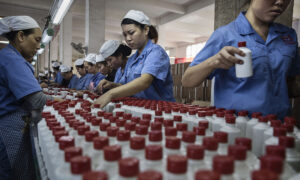
Kyocera, one of the largest chip component manufacturers in the world, believes China can no longer play its role as the global factory amid heavy sanctions from the United States, and the company has begun shifting production to other places, including Japan.
“It works as long as [products are] made in China and sold in China, but the business model of producing in China and exporting abroad is no longer viable,” Hideo Tanimoto, president of Kyocera, said in an interview with the Financial Times. “Not only have wages gone up, but obviously, with all that’s happening between the United States and China, it’s difficult to export from China to some regions.”
Kyocera is building its first factory in Japan in almost 20 years.
On Oct. 7, 2022, the U.S. Department of Commerce announced new export restrictions on chip manufacturing and advanced semiconductors in a bid to prevent American technology from being used in the development of the Chinese military.
Tanimoto admitted that the U.S. export controls were a reason why the firm cut down its operating profit forecast for the year by 31 percent. Kyocera commands a 70 percent market share globally in ceramic components used in chip-manufacturing equipment.
“If chip equipment makers stop shipments to China, our orders will be somewhat affected … They are now even [being] asked not to ship their non-cutting-edge tools,” Tanimoto said.
Back in 2019, when the Trump administration had imposed tariffs on China, Kyocera had moved the manufacturing of copiers for the U.S. market from China to Vietnam.
Moving Production Out of China
Many companies have moved production out of China or plan to do so. In April last year, for example, Apple began manufacturing its iPhone 13 in India at a site owned by Foxconn, its Taiwanese contract manufacturer. In addition, Apple is sending the production of iPads and AirPods to Vietnam.
Samsung shifted production to Vietnam back in 2019. The company has also decided to manufacture its flagship Galaxy S23 smartphones in India for local sale. Amazon has shut down its Kindle facility in China and now produces FireTV devices in India.
Footwear brand Dr. Martens has been reducing its manufacturing dependence on China. Since 2018, the company has shifted 55 percent of total production out of the nation.
“The big message is reducing reliance on China,” Dr. Martens’ chief executive Kenny Wilson said in November, according to the Financial Times. “You don’t want all of your eggs in one basket.”
Declining Investment in China
An analysis by Investment Monitor, a network of B2B websites, shows that greenfield foreign direct investments (FDIs) in China have been falling over the past few years.
Greenfield investment is a type of FDI whereby a parent company sets up a subsidiary in a different nation and builds its business from the ground up, including setting up production facilities, offices, distribution hubs, and so on.
In 2022, greenfield FDI levels into China had halved compared to 2019, according to the analysis. Merger and acquisition deals also fell. Companies were said to be looking to diversify away from the Chinese mainland due to concerns regarding geopolitics and disruption to supply chains.
In China’s tourism sector, greenfield FDI fell by 78 percent between 2019 and 2022. The electronics sector saw greenfield FDI decline by 56.7 percent during this period, financial services by 62.5 percent, logistics 28.6 percent, software and IT services by 48.5 percent, and industrial machinery, equipment, and tools fell by 56.7 percent.]
Some experts foresee more production by American firms being moved to friendlier nations. Governments and corporations are expected to invest “substantially in on-shoring, near-shoring, and friend-shoring for value chains,” said Michael Zezas, head of U.S. public policy research and municipal strategy at Morgan Stanley Research, according to a July 25th post by the investment firm.
“Mexico, India, Vietnam, and Turkey stand out as countries that could benefit from U.S. and European Union companies diversifying value chains.”







